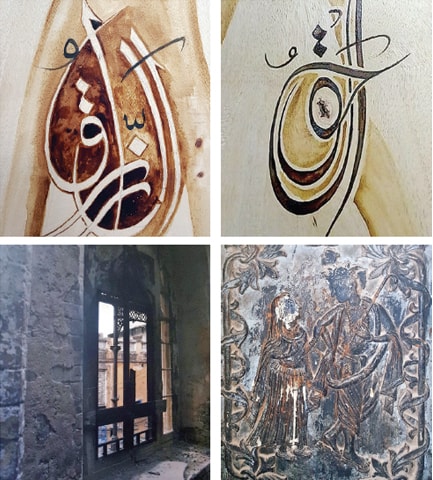
ISLAMABAD: An art exhibition featuring photographs of Rawalpindi’s architectural heritage by Prof Nasir Malik and calligraphy by Riffat Khattak opened on Saturday.
Mr Khattak, a painter, calligrapher and illustrator exhibited over a hundred works of calligraphy, including calligraphy of the 99 names of Allah in khat-i-nasleeq and a series of whirling dervishes in the Turkish and Persian style of takhti (wooden tablets) in black ink and coffee texture.
“The artist has very perfectly played with strokes, texture and node of wood while writing the sacred names,” said artists Zia Zaidi, recalling the early 80s, when Zahoor Akhlaque first introduced calligraphy on takhti.
“It’s romanticism with wood that gives a natural impact,” he said, adding that after around three decades, Mr Khattak had revived the forgotten art with his own unique style.
“The Urdu and Persian scripts have been jotted down in nasleeq font ever since it was first used by Mir Syed Ali Tabrezi in the 9th century,” said Nageen Hyat, the curator and director of Nomad Gallery, where the exhibition was held.
“Later on, many calligraphers from Iran, Afghanistan, Turkey and the subcontinent used khat-e-nasleeq for the art of Khattati or calligraphy and created masterpieces,” she added.
Mr Khattak said: “Takhti, dawaat and qalam have an indelible mark on our memory as we used to write on takhti with qalam in school.”
The art of Islamic calligraphy is fading because of the computerisation of the scripts of local languages in the early 90s, he said.
“Losing this art is a great national loss. The earthen smell of a freshly washed and resurfaced board haunts the ones who used it to this day,” he said.
“When I become distressed, I start writing on takhti and the screech of the pen relaxes me,” he added.
He said he was inspired by Khushal Khan Khattak, one of the great poets of Pashtu and his great grandfather Shamsuddin Khattak, who was also a noted poet and chirographer. Mr Khattak said he has a 300-year-old rare manuscript of Pashtu poetry written by his great grandfather.
He is also inspired by calligraphy on mosques and the Sufi tradition, reflected by the whirling dervishes of Konya in Turkey.
The other artist, Mr Malik, has exhibited sepia-toned photographs of crumbling havelis and other architectural heritage, mainly focusing on Sujjan Singh Haveli, temples and other buildings in Rawalpindi.
He artistically and very minutely uses dark tones and greys to depict the environs and time that have long since vanished.
“My curiosity is my guide and teacher,” commented Mr Malik, a graphic designer, ceramist and glass artist, adding: “I explore the creative world of art as a mixed-media artist.”
Mr Malik formerly worked as the controller of the production, training and camera facilities department at Pakistan Television, the director of the National College of Arts Rawalpindi and visiting faculty at various universities.
While discussing his combination of work and teaching, and his photography techniques, he said: “I have to transfer the experience I have gained to coming generations; thus, I wish to train, teach [and] educate through CAT/AV techniques, using computer graphics, photography, pantograph and methodology management for mind exploring the creative faculties of humans and grooming the young talent of Pakistan into self-supported creative managers.”
Published in Dawn, June 10th, 2018














































Dear visitor, the comments section is undergoing an overhaul and will return soon.